| 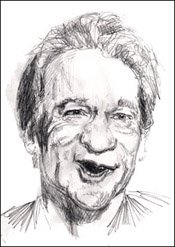
Bill Maher
|
In his book "Drawing Lessons from the Great Masters", Hale points out how all the Masters became masters of anatomy before or during their apprenticeship as artists. They developed intimate insight into the external anatomy (muscles and bones) of the human body well beyond even what most modern day physicians can tell of today.
Not only could they name all the bones, muscles, bony prominences, bony fossas, protuberances, muscle insertions, origins, and functions, but they could draw them accurately, in proportion, with drama - and the kicker: from memory! (Show me one physician or one artist of today who can do that :-) (They knew their stuff. By the way, no disrespect to doctors or artists intended.) In those days they didn't have computers or all the learning aids or distractions that we have today.
|
Getting a game plan
Don't let that scare you away. Do you have to go to these ends to draw pictures like that? No. But to be the absolute best, it helps to be well versed. So we're interested in an in-depth knowledge of just the face for drawing caricatures or portraits - and mastering the main shapes is a great place to start.
(Check out the program at YouCanDraw.com - these guys spoon feed you how to learn all this, they break it down to all the component parts, one feature at a time, handheld exercises and really good explanations, and then learn to reconstruct all those parts into building full fledged, three-D face and caricatures.)
Do you really have to learn all this stuff?
| Do you have to memorize all the facial muscles and their actions to draw portraits and caricatures? Heck no. But can it help, for example, in recognizing what's causing that amazing line around the mouth? Absolutely. You'll be able to make sense of why dimples form where and how they do, as well as make sense of how crow's feet form and look the way they do.
That movie star look - what causes that? (Some will say a prominent maxilla placed over a strong mandible. Does it? Heck, I don't know, but they all seem to have those) And what happens to the bones of the face as we age? Do they start sagging too? (In fact the bones don't change significantly - it's the aging of skin tone and the amount or lack of extra tissue (fat) under the skin that gives that aged look. )
|
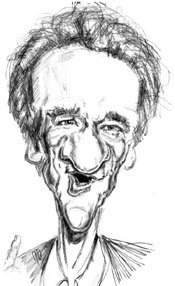
Bill Maher
|
But you don't have to know any of this. It all helps to know about this stuff to make the best pictures possible, but you don't have to have it all memorized to get started. Heck no. You'll know when you want to learn more about anatomy as you progress. It's a very natural step. You'll know when you get there. In fact, you just learn it as you go through the right kinds of lessons.
So where do you start?
| Would you start
looking at the bony
structure underneath
the skin, like this:
|
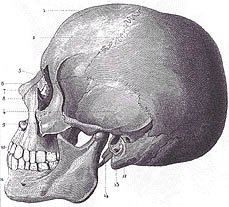 |
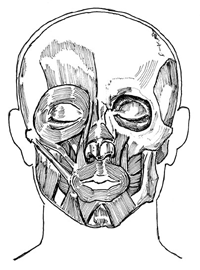 |
Would you start by
learning the
musculature?
|
| Would you start by
learning to draw the
head in terms of
block Shapes?
|
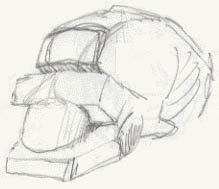 |
Stepping up to three dimensions
How would do you approach drawing in three-dimensions (like when you draw the three-quarter view)? Would you compare everything to a cube? Like this:
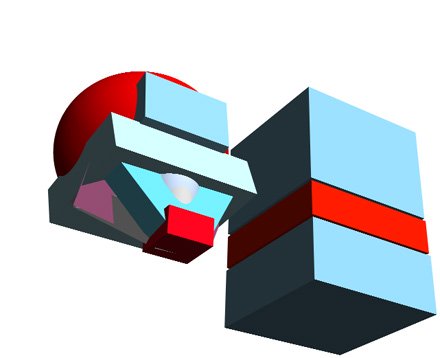
Getting a feel for the heads three-dimensions
and vanishing points
|
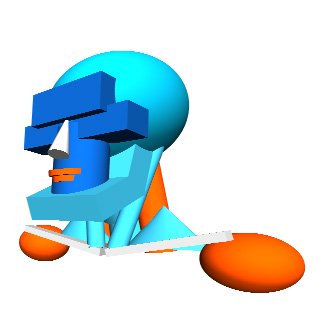
Treating the head and neck as 3-d volumes
|
But don't let that discourage you! Truth is you
can make any one of these your starting point
Seems like a lot! And you know what? We haven't even begun talking about the individual features of the face! Truth is you could start at any of those starting spots we've mentioned. The key is to just pick one manageable, simple puzzle piece at a time.
But we still haven't even looked at the separate features of the face. When you look at all the stuff that goes into learning about drawing the face and head, it almost gets overwhelming. But people do learn - lots of people. You just need to dive in somewhere - and keep it simple!
So what about the features - just five of them?
There's really only five major features you have to worry about (though there are a whole gang of subfeatures - and we'll touch on those too). You could start with any one of those. In fact that's where we'll start -- on one feature at a time.
Where to start? Keep it simple and learn one feature at a time
But here's how I would teach it - or would have loved to have been taught. I'm going to suggest to you to start like this: begin with one feature at a time. And I'd have you start with the simplest features first - the ones that don't lend a lot to the overall look of the person. Which are those? There's one, er actually two: the two ears. :-)
Sometimes I think it would have been so much easier and faster if I had someone to walk me one feature at a time, if they did all the lesson planning and thought through what all we - the students - had to absorb before you could hit the ground drawing faces (that's actually been done by the way :-)
| 12/6/02 - Coming links: So where would you begin drawing the ears?
Let's draw ears: Click here
Hints to drawing eyes: Click here
Hints to drawing noses: Click here
Hints to drawing the mouth, teeth and lips: Click here
|
Or click on any of the following to get transported to their
"how to" draw them page (links will work as soon as the
pages are completed)
Want more work and application? All this has been prearranged -- a whole step by step program put together for you so you don't have to waste time figuring out where to go next. All the assignments are there (with new ones being added all the time) Where might you find something like this? Here: YouCanDraw.com
|
Coming:
The hair and the shapes of the head: click here
Put them on a grid if you like!
Learn how to draw them from different angles
Learn to see their different parts
|
|